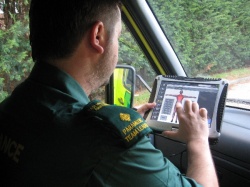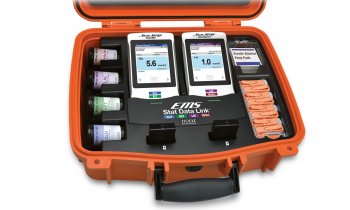Health informatics in practice
Report: Mark Nicholls
The Health Informatics Congress held in the UK this April, revealed how IT is helping health Trusts across the UK to take innovative steps in the way they respond to patients’ needs. The Clinical Showcase session examined how Trusts are coping with new patient administration and reporting systems and, in particular, how Cerner Millennium and Lorenzo systems are being implemented.


While advantages were clear, the session was also informed of the challenges overcome by Trusts to begin to reap the benefits of installing such systems. The session also highlighted how new technology has exposed issues of concern, particularly in laboratory result reporting.
It also looked at how a UK ambulance service is using new technology to record patient details at an emergency site and transmit these to A & E hospital staff ahead of arrival, thus enabling better treatment preparation.
In addition, representatives from the West Midlands Strategic Health Authority outlined areas of IT best practice across its whole region with its IT Treasure Map.
Learning to love Cerner Millennium
Dr Tony Berendt, Executive Medical Director of the Nuffield Orthopaedic Centre in Oxford, outlined the ongoing challenges faced by his Hospital Trust in implementing the Cerner Millennium patient administration system (PAS), acknowledging the well-documented issues with the installation of Cerner R0, from as early as 2006, at the acute specialist NHS Trust, which offers specialist and routine musculoskeletal services and rehabilitation.
‘Our PAS function was poorly developed and we had major disruption to our business processes and patient administration and, as a result, our performance rating with the HCC (Healthcare Commission) was poor,’ he said. ‘There were numerous subsequent “fixes”. We also knew it was problematic in other sites but there had been successful implementations. We identified solutions; the need for strong clinical leadership, pathway redesign and better use of technology.’
Throughout, he said, the Trust remained convinced that EPRs are the way forward and a huge advantage over the usual transportation of paper records around hospitals.
Outlining other EPR advantages for clinicians, Dr Berendt pointed out that a review of notes that formerly took a month to carry out when compiled with paper records had been achieved within five hours electronically.
Nuffield Hospital made improvements, approaching an upgrade to Millennium LC1 by rolling it out from one team to the next to reap the benefits of ‘rolling enthusiasm’ rather than a ‘big bang’ go-live approach. ‘We decided to push ahead with the goal of making Cerner Millennium an integral part of our clinicians’ lives,’ he said, adding that while there are still issues, all clinicians are trained, notes are being signed off electronically and the Trust is already looking at future benefits with Cerner, including general practitioner (GP) communications, use of telephone messaging and patient lists and remote access to the system. Future priorities include an enhanced LC1 upgrade, new work flows, order communications and raised functionality.
His conclusion? It is possible to ‘love Cerner’ and Nuffield’s implementation was progressing with the view that ‘integrating EPRs is a key enabler of improvements in efficiency, safety and the patient experience’.
CSC/iSoft Lorenzo
The session heard how a ‘fictitious’ NHS Trust has been established within the East Midlands Strategic Health Authority to demonstrate to clinicians the benefits of CSC/iSoft Lorenzo.
Dr Tony Penney, a Kettering-based GP who is also Clinical Director of Strategic IM&T for East Midlands SHA, said that not having a product deployed on site meant it could not be seen and felt, adding that, as clinicians, it is important to know what you are getting into. ‘Also, if they can see the benefits of Lorenzo, they will start evangelising about it but, at the moment, until they are signed up for Lorenzo and it’s almost deployed, they don’t get a chance to look at it.’
The answer, he explained, is CLINT (Clinicians NHS Trust), an extra deployment of Lorenzo with ‘dummy’ patients on the latest deployed version. With 60 licences to operate this, there are various clinical scenarios within CLINT to offer clinicians an insight into Lorenzo. Each user is allocated a dedicated laptop, smart card and VPN token with support from the CLINT users group to discover more about Lorenzo.
‘It is not a formal demonstration,’ Dr Penney explained, ‘but the aim is to familiarise clinicians with Lorenzo in small groups.’ Rather than highlighting only design functionality enhancements, the aim is to give clinicians the ‘feel’ of Lorenzo.Feedback is via a share-point site and within the CLINT group there users who know the product in depth and can offer support. The group also now has a place on the principal Lorenzo user group, where clinicians from ‘live’ trusts discuss usability issues enabling anything gleaned from CLINT users to be fed back to CSC/iSoft.
Ambulances and IT
Ambulance Trusts are often the forgotten branch of the health service, suggested Dr John Stephenson, Medical Director of East Midlands Ambulance Service (EMAS) NHS Trust, who outlined how IT was helping the ambulance service to offer better care and potentially improve clinical outcomes for patients.
EMAS ambulance crews now use Siren ePCR Suite, an electronic patient care reporting (ePCR) system from Medusa Medical Technologies, which rapidly captures patient care data using touch-screen technology and provides comprehensive data analysis and reporting capabilities.
Connected remotely via GPRS, the system records the data on a Panasonic Toughbook and transmits it to the A&E department. ‘These records are visible at the hospital once they are recorded by the ambulance crew and are a good way of sharing information and decision making,’ Dr Stephenson said.
Once a 999 call is received, it is fed to the crew’s Toughbook. Once with the patient, pulse, blood pressure and other vital sign details are recorded, along with an ECG, there is a patient mannequin on the laptop to record injuries graphically, and a time-stamped interventions facility that records precisely when interventions took place to provide a highly-accurate record of patient care. All the data is transmitted to A&E staff for better briefing and preparation ahead of the patient’s arrival. ‘What they see from the ECG reading may influence the decision to take the patient direct to the cath lab rather than the emergency department,’ he explained.
EMAS covers a population of 4.6 million people in a geographical area of 6,425 square miles and has 76 locations and 800 vehicles. With 1842 ambulance staff and 203 ambulance control staff, it handles 550,000 emergency calls annually.
While there have been transmission issues in rural areas and the problem of transmitting while a vehicle is travelling at speed, Dr Stephenson said solutions were in place to address this with 3G technology available.
An e-mail summary of what has occurred to the patient is also sent to the patient’s GP with the information forming part of the patient’s EPR.
Funding for Siren has been provided by the SHA, with training rolled out across the ambulance Trust and to hospital staff. ‘This has been a major change for ambulance staff, from using tick boxes on paper to recording data on computer but for receiving locations they now have a real reference for patients, received in advance,’ Dr Stephenson pointed out.
Future developments could mean spine connectivity, access to summary care records for ambulance crews to view a patient’s allergies and current medication, working with the NHS Pathway triage system, and could see ambulance staff contributing to the patient’s primary care record.
The system is established across Derbyshire and Nottinghamshire and will be rolled out across the whole of the EMAS area (six counties) by September 2011.
Flaws in lab test results
With an EPR now potentially being built up from a number of sources, often with tests carried out at several different laboratories, a lack of uniformity in testing levels has emerged, which could mean confused and dangerous results.
Dr Rick Jones, Associate Clinical Director of the Yorks and Humber Programme for IT and Senior Lecturer at the Yorkshire Centre for Health Informatics, University of Leeds, presented the session The hidden dangers of mixing clinical data across systems in the absence of scientific understanding, to highlight this issue. ‘Trusts are requesting analysis that is interpreted to see what is wrong with the patient. In the old world the hospital lab would work with the surrounding GP service.’ But now, in a world, where IT has eroded boundaries, these tests can be conducted at different laboratories, with many having slightly different interpretation levels and different reference ranges for specific tests. ‘People are having tests done all the time at different laboratories in different places, but with this different data getting merged together,’ he pointed out. ‘If it is not consistent, we are getting inconsistent results.
With the EPR, people are getting data from all over the country, but what is measured in Scotland, for example, may differ to what is measured in parts of England.’
Dr Jones pointed out that PSA testing for prostate cancer, where slightly different scales and interpretations for high or low levels can be used from one laboratory to another, could give results varying by as much as 20%, or variations in the classification of patients with chronic kidney disease and their eGFR (estimated Glomerular Filtration Rate).
He also underlined the need to align pathology standards and information standards in the UK. Over the last three years, work has been underway to address this issue.
Harmonising pathology
Dr Jonathan Berg, Pathology Director for Sandwell and West Birmingham Hospital NHS Trust, explained that his team had taken steps harmonise pathology testing with the Pathology Harmony initiative. ‘When we looked at laboratories, we found that reference ranges were different from those in neighbouring laboratories for the same tests. Different labs had different criteria for abnormal test results.’
Early in the project, begun in 2007, the team saw the need to harmonise test results across all laboratories. It suggested 35 key areas of harmonisation of results and the need to work towards national consolidation of results and countrywide implementation. A national UK steering group on the subject has now been established.
IT gems
Dr Masood Nazir and Nurse Karen King, from West Midlands SHA, used an illustrated IT treasure map of their area to highlight ‘gems’ that had set high standards and enabled them to meet their vision of introducing new IT systems to ‘help to deliver better, safer and more connected care’ and how ‘better information was leading to better healthcare for every patient’.
Criteria for ‘gems’ selection were their easy, quick implementation, cost effectiveness and benefits. Examples included mobile working with real-time access to patient records at the point of care, Choose and Book in the Sandwell PCT area with a 90% referral target; successful implementation of Lorenzo Podiatry; better links between ambulance crews and A&E departments; an effective Electronic Discharge Summary system within NHS Hereford, and extending Choose and Book to book a physiotherapy appointment at University Hospitals Birmingham and NHS Hereford.
The developments are under the West Midlands Quality, Innovation, Productivity and Prevention Challenge.
‘To improve patient care,’ Dr Nazir explained, ‘we need to share information and the spread of innovation will improve quality. Technology can also help improve patient safety.’ The examples, he added, can be shared across West Midlands to reduce inequalities in healthcare.
Mrs King said future developments include wider sharing of PACS images and the use of telehealth.
07.07.2010











